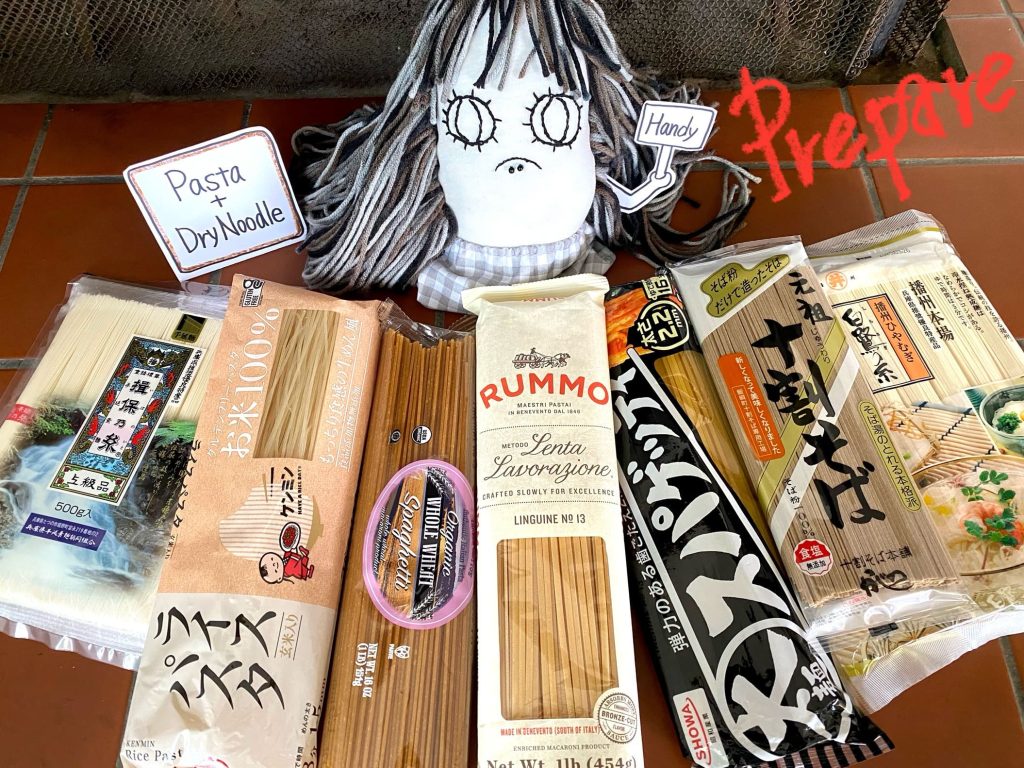
Which pasta and dry noodles are best for our long-term emergency stockpile?
Pasta is good, my whole family can eat it!!
Pasta and dry noodles need a lot of water, right?
Is it possible to cook it in an emergency?
I know about pasta, but I don’t know much about other types of noodles…
Pasta and noodles aren’t everybody’s absolute favorite, but most people like them. Almost everyone can eat pasta and noodles without problems. Even picky eaters like them well enough. We don’t need to make homemade pasta and noodles from flour; we can simply buy dry pasta and dry noodles. They’re very convenient and easy to cook. Incredibly, dry pasta can keep for over 10 years if you store it right.
There is no reason not to store pasta/noodles in your long-term stockpile.
There are many different kinds of pasta and noodles, but I chose spaghetti, buckwheat noodles, somen noodles, and udon.
I picked them, primarily, because of their shape. The long, thin shape makes them very easy to store, and when you need to cook them, it’s easy to make them small by simply snapping them into pieces.
Spaghetti
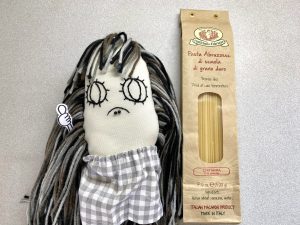
All pasta is not created equal. Egg pasta and fancy flavored pastas tend to have a shorter shelf life. Their ingredients can make them spoil faster. Whole wheat pasta, because it is made from whole grain wheat flour and retains more of the wheat’s nutrients and fiber than refined pasta, may also not have as long a shelf life. So, I got hard, durum wheat pasta (semolina).
Buckwheat Noodles
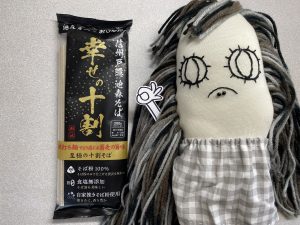
Japanese call buckwheat noodles “SOBA”. It is high in fiber and protein, rich in minerals such as manganese, iron, and zinc, and high in vitamin B. There are different types of soba noodles, with varying ratios of buckwheat flour to wheat flour, ranging from juwari soba (100% buckwheat) to ni-hachi soba (80% buckwheat, 20% wheat flour). These variations can affect both flavor and nutritional value, as well as whether the noodles are gluten-free.
Somen, Udon, Hiyamugi, and Kishimen noodles
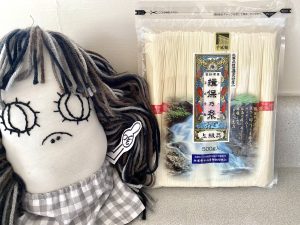
These noodles are all made from the same ingredients – wheat flour, water, and a little salt. The only difference is the thickness of the noodles. There is actually no difference in taste. The mild flavor and delicate texture of these white noodles make them adaptable for serving cold or hot, with lighter-flavored sauces and broths. Cold noodles are popular in Japan during the sweltering summer season when one has little appetite. The noodles cook quickly and go down easily.
💡
We don’t need to make homemade pasta and noodles from flour; we can simply buy dry pasta and dry noodles. They’re very convenient and easy to cook.
How to store
Put your pasta or noodles in mylar bags with oxygen absorbers. Then put them into a strong container to protect against animals and bugs. Some people recommend removing the original packaging because it is not airtight. The reasoning is that if your pasta comes in a loosely-sealed cardboard box, for example, it will allow moisture, odors, and contaminants to seep through; and over time, your unprotected pasta will lose its taste, texture, and nutritional value. Another concern, if your noodles come in plastic packaging, is that your noodles will end up tasting like plastic after years of storage.
Therefore, if the original packaging is made of paper, you don’t need to remove it. But if it is a plastic package, then remove the packaging and use a paper bag or newspaper wrap, etc. Then put everything into mylar bags, to help keep them fresh for longer. (Be careful. Pasta and noodles’ tips are sharp, and they might poke through your mylar bag.)
Things to Remember
▪︎ Keep your food in a cool, dry place. No high humidity and no direct sunlight.
▪︎ Please do not forget that before eating long-term stockpile foods, absolutely check the food’s appearance and smell. Trust your five senses. Eat them at your own risk.
Wait a minute… How about pasta sauce??? How about noodle soup??
Yes! That is the problem. If you can eat pasta and noodles without any sauce and without soup, you will be just fine. But I am not OK with that! I can’t eat plain noodles. Tomato sauce does not keep very long, and it takes up a lot of space. I don’t want to buy sauce and soup just for pasta and noodles. Maybe it would be ok for my short-term stockpile, if I roll through them, but right now I am setting up my long-term stockpile. We need to keep this food as long as possible.
This is my plan for eating dry pasta or noodles in an emergency. (Maybe you already know this technique?)
★ Pasta
1. Cut your pasta as small as possible.
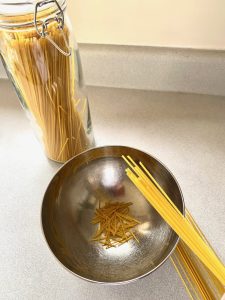
2. Put pasta in water and soak for 3 hours. During this time, if you want to, you can add salt.
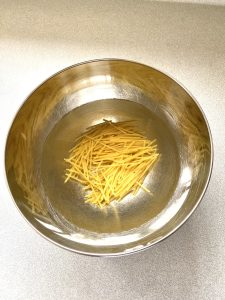
Soaking pasta this way saves energy.
You don’t need to boil water.
Different types of pasta and noodles can be prepared in this way, but soaking times will vary.
3. When your pasta becomes soft, it’s ready to eat.
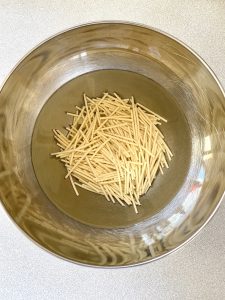
4. I recommend you add your noodles to your favorite soup or mix it with sugar and soybean flour (KINAKO).
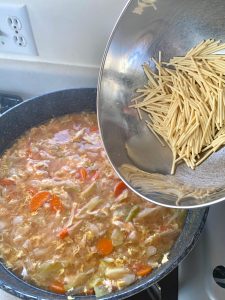
5. Enjoy!
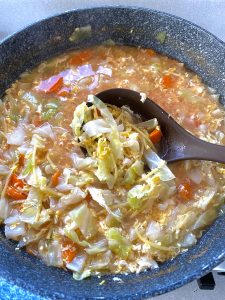
★ Somen
1. Make your favorite soup.
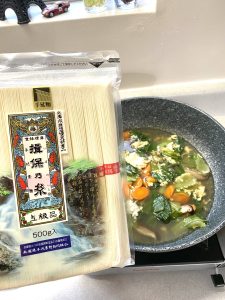
2. Add noodles. Cook noddle until soft.
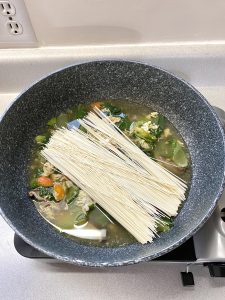
3. Enjoy!
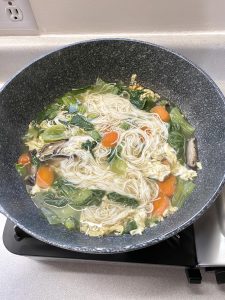
Personally, I prefer rice to pasta and noodles. Rice takes up less space and, in my opinion, tastes better. I do include pasta and noodles in my long-term stockpile, but not too much, mainly because I feel like I’m wasting all of my space to keep sauce and soup just for them.
See you next time.
Remember, “Protect your life by yourself” (自分の命は自分で守る). You need to survive first, and then you need your emergency supply. No matter how well you prepared your emergency supplies, if you die, then all of your preparations will have been for nothing. First and foremost, keep your health up all the time. Build your stamina so that if you need to, you can evacuate as quickly as possible. Stay healthy.